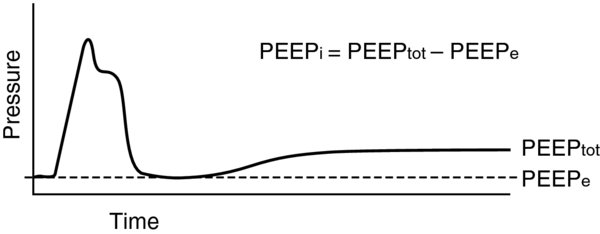Description
- The I:E ratio describes the duration of inspiration to the duration of expiration.
- Each complete ventilator breath has an allotted time for inspiration time for inspiration (I-time) before the ventilator must cycle into exhalation time (E-time).
- The sum of the I-time E-time equals the allotted time per breath (total duration).
- The ventilator delivers a set number of breaths per minute, or ventilator frequency this determines the length of each breath. A frequency of 20 would result in 3 seconds/breath whereas a frequency of 10 would result in 6 seconds/breath.
- Programming the I:E ratio
- Generous I-time allows recruitment of collapsed lung segments.
- Adequate E-time avoids gas trapping.
- Inspiratory time. Describes the time over which the tidal volume is delivered (volume control (VC) or the pressure is maintained (pressure control).
- Sufficient I-time is needed to allow distribution of the positive pressure inspiratory volume recruit collapsed lung segments (redistribution of gas from more compliant alveoli to less compliant alveoli). Sustained elevations in airway pressure may recruit lung units more effectively than transient increases. Additionally, sustained alveolar inflation appears to decrease dead space, perhaps by facilitating the delivery of gas to well perfused (less compliant) areas.
- Volume-controlled ventilation. As the I-time is increased, peak inspiratory pressures turbulence decrease; there is more time to deliver the set volume. Decreased peak pressures also allow for improved venous return to the right atrium ( cardiac output) particularly in volume-depleted patients.
- Inspiratory pause. Following the tidal volume delivery, a pause may be programmed to maintain inflation of the alveoli (optimize ventilation to perfusion). This pause occurs during the programmed I-time: I:E = (inspiratory time + inspiratory pause time):expiration
- Pressure-controlled ventilation (PCV). As the I-time is increased, larger tidal volumes decreased turbulence result; there is more time to recruit collapsed lung segments at a given pressure.
- Expiratory time. Sufficient E-time is needed to allow alveoli to empty prior to the subsequent positive pressure inspiratory breath.
- Selecting an I:E ratio is a balance between decreasing turbulence peak pressures increasing tidal volumes against allowing enough time for exhalation preserving preload.
- Adults. Normal spontaneous ventilation usually ranges from 1:1.5 to 1:2.5.
- Children. The I:E ratio during normal spontaneous ventilation in young children is typically 1:3.
- Inverse respiratory ventilation (IRV). In theory, prolongation of the inspiratory time can maintain mean airway pressures (MAP) tidal volume at lower levels of positive end-expiratory pressure (PEEP) peak alveolar pressure, provided that excessive end-expiratory gas trapping does not occur.
Physiology/Pathophysiology
- Hypoventilation respiratory acidosis may occur if there is insufficient time for tidal volume delivery or pressure limits are reached prematurely.
- Gas trapping occurs if there is insufficient time for alveoli to empty before the next breath. This can result in progressive hyperinflation of alveoli progressive rise in end-expiratory pressure (known as auto-PEEP) with resultant barotrauma or cardiovascular compromise due to high intrathoracic pressures. Situations where this may result include:
- Increased inspiratory time or inverse inspiratory time, compared to expiration
- Obstructive disease states such as asthma or chronic obstructive pulmonary disease (COPD)
- High respiratory rates, resulting in a shortened absolute expiratory time. Has been observed with high-frequency oscillatory ventilation (HFOV).
- Time cycling is used for pressure, volume, dual controlled (VC with pressure limits) modes. Either the I:E ratio or inspiratory time is set flows are adjusted accordingly to ensure that the set tidal volume is delivered.
- Volume-cycled. The flow is set the inspiration ends when the set tidal volume has been delivered.
- Hypoxemia not responding to increased FiO2. Inverse I:E ratio can facilitate redistribution of the tidal volume from more compliant to less compliant alveoli. Under general anesthesia this is well-tolerated, but in the awake or mildly sedated patient, this is poorly tolerated.
- Acute respiratory distress syndrome (ARDS). Inverse I:E ratios have been utilized to reduce peak inspiratory pressures barotrauma. Additionally, a long, sustained inspiration reduces the mean airway pressure while increasing the PaO2 for a given FiO2. Despite the benefits in gas exchange, the prolonged inspiratory duration relative to expiration is uncomfortable for the alert patient, paralysis may be required. However, the effects of PCV with different I:E ratios on respiratory mechanics, gas exchange, hemodynamics in patients with adult respiratory distress syndrome have failed to show any short-term beneficial effect of PCV or PCIRV (inverse ratio) over conventional VC with PEEP in patients with ARDS (1).
| I:E | I-time (s) | E-time (s) | I-time (s) | E-time (s) |
|---|---|---|---|---|
| ratio | RR 10 | RR 10 | for RR 6 | for RR 6 |
| 1:4 | 1.2 | 4.8 | 2 | 8 |
| 1:3 | 1.5 | 4.5 | 2.5 | 7.5 |
| 1:2.5 | 1.7 | 4.3 | 2.8 | 7.2 |
| 1:2 | 2 | 4 | 3.3 | 6.6 |
| 1:1.5 | 2.4 | 3.6 | 4 | 6 |
| 1:1 | 3 | 3 | 5 | 5 |
| 1.5:1 | 3.6 | 2.4 | 6 | 4 |
RR = 10 correlates to 6 seconds/breath. 6 is divided by the I-time plus the E-time (6/[I-time + E-time]). for example, for an I:E ratio of 1:4, 6/(1 + 4) = 6/5 = 1.2 seconds. This value is multiplied by the ratio value; for example 1.2 × 1 = 1.2 seconds for the I-time 1.2 × 4 = 4.8 seconds for the E-time. Note: the I-time plus the E-time should equal 6 seconds.
FIGURE 1. Measuring intrinsic PEEP: quantitative measurement of intrinsic PEEP can be obtained in an apneic patient by using the expiratory pause hold control on the ventilator. This allows equilibration of pressures between the alveoli the ventilator allowing the total PEEP to be measured. The value for total PEEP can be read from the airway pressure dial or the PEEP display.
Intrinsic PEEP = Total PEEP - Set PEEP
